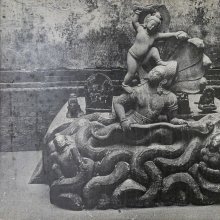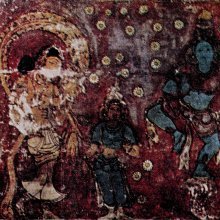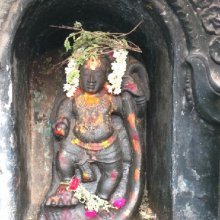Kaliya, Kālīya, Kāliyā, Kāliya, Kaḻiya: 20 definitions
Introduction:
Kaliya means something in Hinduism, Sanskrit, Jainism, Prakrit, Buddhism, Pali, Hindi, biology, Tamil. If you want to know the exact meaning, history, etymology or English translation of this term then check out the descriptions on this page. Add your comment or reference to a book if you want to contribute to this summary article.
Images (photo gallery)
In Hinduism
Natyashastra (theatrics and dramaturgy)
Source: Wisdom Library: Nāṭya-śāstraKāliya (कालिय) is the Sanskrit name of one of Bharata’s sons, mentioned in the Nāṭyaśāstra 1.26-33. After Brahmā created the Nāṭyaveda (nāṭyaśāstra), he ordered Bharata to teach the science to his (one hundred) sons. Bharata thus learned the Nāṭyaveda from Brahmā, and then made his sons study and learn its proper application. After their study, Bharata assigned his sons (eg., Kāliya) various roles suitable to them.

Natyashastra (नाट्यशास्त्र, nāṭyaśāstra) refers to both the ancient Indian tradition (shastra) of performing arts, (natya—theatrics, drama, dance, music), as well as the name of a Sanskrit work dealing with these subjects. It also teaches the rules for composing Dramatic plays (nataka), construction and performance of Theater, and Poetic works (kavya).
Vaishnavism (Vaishava dharma)
Source: ISKCON Press: GlossaryKāliya (कालिय).—The many-headed serpent chastised by Lord Kṛṣṇa for poisoning a section of the Yamunā River.

Vaishnava (वैष्णव, vaiṣṇava) or vaishnavism (vaiṣṇavism) represents a tradition of Hinduism worshipping Vishnu as the supreme Lord. Similar to the Shaktism and Shaivism traditions, Vaishnavism also developed as an individual movement, famous for its exposition of the dashavatara (‘ten avatars of Vishnu’).
Purana and Itihasa (epic history)
Source: archive.org: Puranic EncyclopediaKāliya (कालिय).—Birth. Kaśyapa, grandson of Brahmā and son of Marīci begot of his wife Kadrū powerful nāgas like Śeṣa, Airāvata, Takṣaka, Kārkoṭaka, Kāliya, Maṇināga, Purāṇanāga etc. and from them were born all kinds of nāgas on earth. (Ādi Parva, Chapter 35). Kāliya possessed one thousand heads. (Bhāgavata, 10th Skandha). (See full article at Story of Kāliya from the Puranic encyclopaedia by Vettam Mani)
Source: Cologne Digital Sanskrit Dictionaries: The Purana Index1a) Kāliya (कालिय).—A chief of the Krodhavaśa group of serpents. Got into a pool of the Yamunā, causing the death of people who drank of the waters. Kṛṣṇa subjugated it and ordered it to go to the sea, thus making the waters drinkable. He assured Kālīya of freedom from Garuḍa's hostility. Son of Kadru, Kāliya originally lived in Ramaṇaka, and refused to give Bali to Garuḍa according to an agreement with him. In the fight that ensued, Kāliya was vanquished, and he resorted to the Kālindi pool where Garuḍa could not come. But he was expelled by Kṛṣṇa.1 In the Atalam region;2 in Talvalam ?3
- 1) Bhāgavata-purāṇa V. 24. 29; X. ch. 16 (whole); 17. 1-12; X. 43. 26.
- 2) Vāyu-purāṇa 50. 18; 69. 72.
- 3) Brahmāṇḍa-purāṇa II. 20. 19; Matsya-purāṇa 163. 56.
1b) A dānava king.*
- * Brahmāṇḍa-purāṇa IV. 29. 124.
1c) The serpents of Mahātalam.*
- * Bhāgavata-purāṇa V. 24. 29.
Kāliya (कालिय) is a name mentioned in the Mahābhārata (cf. I.31.6, I.35, V.101.9/V.103) and represents one of the many proper names used for people and places. Note: The Mahābhārata (mentioning Kāliya) is a Sanskrit epic poem consisting of 100,000 ślokas (metrical verses) and is over 2000 years old.
Source: Shodhganga: Kasyapa Samhita—Text on Visha Chikitsa (itihasa)Kāliya is the name of a Serpent (sarpa) mentioned in the thirty-fifth chapter (verses 4-17) of the Ādiparva of the Mahābhārata.—Accordingly, Sauti, on being implored by Śaunaka to name all the serpents in the course of the sarpa-sattra, tells him that it is humanly impossible to give a complete list because of their sheer multiplicity; but would name the prominent ones in accordance with their significance [e.g., Kāliya].

The Purana (पुराण, purāṇas) refers to Sanskrit literature preserving ancient India’s vast cultural history, including historical legends, religious ceremonies, various arts and sciences. The eighteen mahapuranas total over 400,000 shlokas (metrical couplets) and date to at least several centuries BCE.
General definition (in Hinduism)
Source: WikiPedia: HinduismKāliyā (कालिया): Kāliyā was the name of a poisonous hydra or Nāga living on the bank of Yamuna River. Kāliyā was quelled by Krishna and sent to his abode in Ramanaka Dwīpa.
In Jainism
General definition (in Jainism)
Source: JAINpedia: JainismKāliya (कालिय) in Prakrit (Kālika in Sanskrit) refers to “related to when to study scriptures” and represents an example of Suyanāṇa (Śrutajñāna) or “scriptural knowledge” (knowledge from what is heard) which represents one of the five types of knowledge, as explained in the Nandīsūtra.—Examples of Kāliya are (1) “can only be studied at fixed times, namely the first and last quarters of the day and night”; (2) “titles of works are provided, some of which correspond to extant works while others are lost”.

Jainism is an Indian religion of Dharma whose doctrine revolves around harmlessness (ahimsa) towards every living being. The two major branches (Digambara and Svetambara) of Jainism stimulate self-control (or, shramana, ‘self-reliance’) and spiritual development through a path of peace for the soul to progess to the ultimate goal.
Biology (plants and animals)
Source: Google Books: CRC World Dictionary (Regional names)Kaliya in India is the name of a plant defined with Tridax procumbens in various botanical sources. This page contains potential references in Ayurveda, modern medicine, and other folk traditions or local practices It has the synonym Balbisia canescens Pers. (among others).
Example references for further research on medicinal uses or toxicity (see latin names for full list):
· Enum. Pl. (1809)
· Verzeichniss der Pflanzenkulturen (1824)
· Flora Cochinchinensis (1790)
· Species Plantarum (1753)
· Annales des Sciences Naturelles (1831)
· Prodromus Systematis Naturalis Regni Vegetabilis (DC.) (1836)
If you are looking for specific details regarding Kaliya, for example chemical composition, pregnancy safety, diet and recipes, extract dosage, health benefits, side effects, have a look at these references.

This sections includes definitions from the five kingdoms of living things: Animals, Plants, Fungi, Protists and Monera. It will include both the official binomial nomenclature (scientific names usually in Latin) as well as regional spellings and variants.
Languages of India and abroad
Pali-English dictionary
Source: BuddhaSasana: Concise Pali-English Dictionarykālīya : (nt.) gallochum. || kāḷīya (nt.), gallochum.
Source: Sutta: The Pali Text Society's Pali-English DictionaryKālīya, a kind of (shiny) sandal wood; so to be read for tālīsa at Vin. I, 203 (see note on p. 381). (Page 212)

Pali is the language of the Tipiṭaka, which is the sacred canon of Theravāda Buddhism and contains much of the Buddha’s speech. Closeley related to Sanskrit, both languages are used interchangeably between religions.
Sanskrit dictionary
Source: DDSA: The practical Sanskrit-English dictionaryKāliya (कालिय).—Relating to time, timely.
-yaḥ The Kaliyuga.
--- OR ---
Kāliya (कालिय).—Name of a tremendously large serpent who dwelt at the bottom of the Yamunā (which was a ground forbidden to Garuḍa, the enemy of serpents, owing to the curse of the sage Saubhari). He was crushed to death by Kṛṣṇa when he was but a boy; R.6.49; Śiśupālavadha 17.69.
-yāḥ (pl.) The family of black serpents; Śiśupālavadha 19.28.
Derivable forms: kāliyaḥ (कालियः).
--- OR ---
Kālīya (कालीय).—[kāla-cha] A kind of sandal-wood; also कालीयक (kālīyaka).
Derivable forms: kālīyam (कालीयम्).
Source: Cologne Digital Sanskrit Dictionaries: Shabda-Sagara Sanskrit-English DictionaryKāliya (कालिय).—mfn.
(-yaḥ-yā-yaṃ) Relating to time, &c. m.
(-yaḥ) A serpent destroyed by Krishna. E. kāla, and gha aff.
--- OR ---
Kālīya (कालीय).—mfn.
(-yaḥ-yā-yaṃ) Relating to time, to blackness, &c. n.
(-yaṃ) A dark of kind of Sandal, or perhaps of Agallochum: see kālīyaka. E. kāla black, and cha aff.
Source: Cologne Digital Sanskrit Dictionaries: Benfey Sanskrit-English DictionaryKāliya (कालिय).—i. e. 2. kāla + iya, m. The name of a Nāga, Mahābhārata 1, 1551.
--- OR ---
Kālīya (कालीय).—i. e. 2. kāla + īya, n. A dark kind of sandal, [Suśruta] 2, 120, 15.
Source: Cologne Digital Sanskrit Dictionaries: Monier-Williams Sanskrit-English Dictionary1) Kāliya (कालिय):—[from kāla] a m. Name of a Nāga (inhabiting the Yamunā, slain by Kṛṣṇa, also written kālīya, [Viṣṇu-purāṇa]), [Mahābhārata; Harivaṃśa etc.]
2) Kālīya (कालीय):—[from kāla] a m. = kāliya
3) [v.s. ...] n. a dark kind of sandal-wood, [Suśruta]
4) Kāliya (कालिय):—[from kāliman] b etc. See, [ib.]
5) Kālīya (कालीय):—b See p. 278, col. 1.
Source: Cologne Digital Sanskrit Dictionaries: Yates Sanskrit-English Dictionary1) Kāliya (कालिय):—[(yaḥ-yā-yaṃ) a.] Relating to time. m. A serpent.
2) Kālīya (कालीय):—(yaṃ) 1. n. A dark kind of sandal. a. Relating to time.
[Sanskrit to German]
Sanskrit, also spelled संस्कृतम् (saṃskṛtam), is an ancient language of India commonly seen as the grandmother of the Indo-European language family (even English!). Closely allied with Prakrit and Pali, Sanskrit is more exhaustive in both grammar and terms and has the most extensive collection of literature in the world, greatly surpassing its sister-languages Greek and Latin.
Hindi dictionary
Source: DDSA: A practical Hindi-English dictionaryKaliyā (कलिया):—(nm) meat-curry.
...
Prakrit-English dictionary
Source: DDSA: Paia-sadda-mahannavo; a comprehensive Prakrit Hindi dictionary1) Kāliya (कालिय) in the Prakrit language is related to the Sanskrit word: Kālaya.
2) Kāliya (कालिय) also relates to the Sanskrit word: Kālika.
Prakrit is an ancient language closely associated with both Pali and Sanskrit. Jain literature is often composed in this language or sub-dialects, such as the Agamas and their commentaries which are written in Ardhamagadhi and Maharashtri Prakrit. The earliest extant texts can be dated to as early as the 4th century BCE although core portions might be older.
Kannada-English dictionary
Source: Alar: Kannada-English corpusKaḷiya (ಕಳಿಯ):—[adjective] (dial.) that is essential or important; absolutely necessary; indispensable.
--- OR ---
Kāḷiya (ಕಾಳಿಯ):—
1) [noun] = ಕಾಳಿಂಗ - [kalimga -] 5.
2) [noun] a mythological snake subdued by Křṣṇa.
Kannada is a Dravidian language (as opposed to the Indo-European language family) mainly spoken in the southwestern region of India.
See also (Relevant definitions)
Starts with (+36): Kal-iyaipacam, Kaliya-lata, Kaliyacha, Kaliyadake, Kaliyadalana, Kaliyadamana, Kaliyajit, Kaliyaka, Kaliyakam, Kaliyakara, Kaliyal, Kaliyalar, Kaliyalati, Kaliyalmaru, Kaliyam, Kaliyamadu, Kaliyamardana, Kaliyamathana, Kaliyamman pathiri chedi, Kaliyana marukka.
Ends with: A-candra-aditya-kaliya, Akaliya, Eshyatkaliya, Kakaliya, Kokalika, Mamdukkaliya, Skaliya, Tulyakaliya, Ukkaliya, Vatakalakaliya, Visakaliya.
Full-text (+42): Kaliyaka, Kaliyadamana, Kaliyamardana, Ramanakadvipa, Navanaga, Kaleya, Kalika, Kaliyajit, Vrindavana, Krishnapadacihnita, Eshyatkaliya, Talikkayiru, Tulyakaliya, Kalaya, Ahijit, A-candra-aditya-kaliya, Kaliyavar, Tulya, Kaliyam, Kaliyanayanar.
Relevant text
Search found 58 books and stories containing Kaliya, Kaaliyaa, Kāli-ā, Kali-a, Kālīya, Kāliyā, Kāliya, Kaliyā, Kaḷiya, Kāḷiya, Kaḻiya, Kazhiya; (plurals include: Kaliyas, Kaaliyaas, ās, as, Kālīyas, Kāliyās, Kāliyas, Kaliyās, Kaḷiyas, Kāḷiyas, Kaḻiyas, Kazhiyas). You can also click to the full overview containing English textual excerpts. Below are direct links for the most relevant articles:
Garga Samhita (English) (by Danavir Goswami)
Verse 2.12.21 < [Chapter 12 - Subduing Kāliya and Drinking the Forest Fire]
Verse 2.14.21 < [Chapter 14 - Description of Kāliya’s Story]
Verse 2.12.22 < [Chapter 12 - Subduing Kāliya and Drinking the Forest Fire]
Śrī Kṛṣṇa-vijaya (by Śrī Gunaraja Khan)
Brihad Bhagavatamrita (commentary) (by Śrī Śrīmad Bhaktivedānta Nārāyana Gosvāmī Mahārāja)
Verse 1.2.72-75 < [Chapter 2 - Divya (the celestial plane)]
Verse 1.5.29 < [Chapter 5 - Priya (the beloved devotees)]
Verse 1.6.120 < [Chapter 6 - Priyatama (the most beloved devotees)]
Chaitanya Bhagavata (by Bhumipati Dāsa)
Verse 3.5.740 < [Chapter 5 - The Pastimes of Nityānanda]
Verse 2.13.299 < [Chapter 13 - The Deliverance of Jagāi and Mādhāi]
Verse 1.16.203 < [Chapter 16 - The Glories of Śrī Haridāsa Ṭhākura]
The Vishnu Purana (by Horace Hayman Wilson)
Chapter VII - Chastisement of Kaliya < [Book V]
Chapter VIII - Destruction of demon Dhenuka < [Book V]
Chapter XIII - Herdsmen appraised Krishna < [Book V]
Related products




